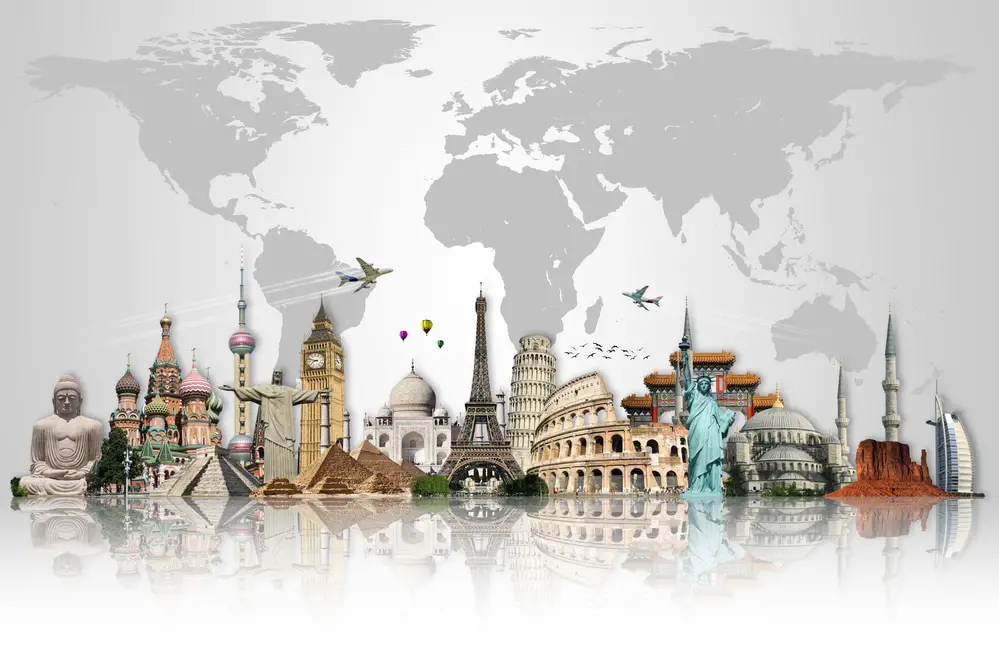
CommonCentsMom.com is advertiser-supported: we may earn compensation from the products and offers mentioned in this article. However, any expressed opinions are our own and aren't influenced by compensation. The contents of the CommonCentsMom.com website, such as text, graphics, images, and other material contained on this site (“Content”) are for informational purposes only. The Content is not intended to be a substitute for professional financial or legal advice. Always seek the advice of your Financial Advisor, CPA and Lawyer with any questions you may have regarding your situation. Never disregard professional advice or delay in seeking it because of something you have read on this website!
QUICK ANSWER: To travel to every country in the world, it would cost you $96,000 if you spent only one day in each country. If you spent 3 days in each country, it would cost you $289,500. If you spent 1 week in each country, it would cost you $675,500 and it would take 3.7 years to finish your round-the-world trip.
As soon as one receives their first passport book, the dreams of filling it with visas and stamps start drifting into their heads. From eating local cuisines and learning traditions, to hiking some of the most breathtaking places known to man, the world offers plenty of dreams to chase after.
With over 190 nations in existence, there’s no shortages of places to explore. But what if you wanted to visit every country at least once? How much would it truly cost to travel to every country in the world?
Before You Begin: Settling Business at Home
Prior to charting your course, it’s critical to start your planning at home. Taking time for an around-the-world trip requires many of resources, including a starting budget and reduced obligations.
Starting your big voyage should start with plotting your financial picture. Because you may not be earning regular income while on the road, it’s important to ensure you not only have enough to start, but also extra to cover unforeseen emergencies. Additionally, you will also need to plan for any obligations you leave behind, like housing payments and outstanding debt.
Making an around-the-world trip requires careful financial planning. As part of your strategy, be sure to have plans for housing before and after your trip, as well as a way to take care of any bills you may have to pay.
Setting expectations and creating a plan
For many people, it may be impossible to actually visit every country in the world. For example: American nationals are banned from visiting Iran and North Korea, while Canadian nationals are warned to stay away from the African nations of Burundi and the Central African Republic.
Those details notwithstanding, the first step in any grand adventure is setting a plan and expectations. Transportation, accommodations and food will all need to be added to your daily budget. The prices for meals every day and a bed at night will change based on where you are going. While the average hotel rate in Paris, France was around $269 per night in 2019, while the average daily hotel rate in Phuket, Thailand in 2019 was closer to $100 per night.
To begin setting up your quest to travel to every country in the world, start by charting your course on the map, and research any visas you may have to get ahead of time and their cost. This goal should take into account the time you have available to travel, any anticipated average expenses per day, and transportation costs to get between point to point.
Traveling Within Scales of Economy
Although traveling from country-to-country is an expensive proposition, it doesn’t have to be out of reach. As you process your planning, there are plenty of ways to reduce costs and go efficiently from country to country.
First, minimize your anticipated air travel. Aside from traveling overseas, air travel can be expensive and unnecessary when going on the land. Trains and buses are not only more economic, but allows you to maximize your ability to visit more countries. As you plot your course, always look for ways to travel over roads and railways first.
Second, consider how to save money when looking for accommodations in foreign cities. While hotels can be expensive, person-to-person websites like AirBNB, Homestay and VRBO can offer lower cost alternatives with local hosts. If you’re traveling to a place where these options aren’t available, hostels can offer a budget-friendly alternative. Before booking either option, be sure to read reviews and understand you may be staying with hosts or other travelers with shared facilities. By understanding what you are getting into, you can ensure that you are getting accommodations that meet your expectations.
Finally, consider any hotel points, airline miles, or cash back you may have earned through credit card spending. Frequent flyer miles can reduce the amount you will need to spend on airplane tickets, while hotel points can be used to get free hotel nights. Using points, miles and cash back earned by your everyday spending, you can stretch your budget even further and enjoy your trip even further.
Setting an Around-The-World Trip Budget
You’ve plotted your course and set a date. The time has come to set a budget for those international travel. How much should you dedicate per person, per day?
As a starting point, you can expect to spend an average of $500 per person, per day.
This $500 budget will cover:
1. Lodging (Hotels, hostels, etc.)
2. Daily meals (Breakfast and dinner, at a minimum)
3. Transportation from city to city
4. Extra incidentals you may need
It’s important to remember that this is a rolling average per day, and not every city or stopover will consume the full amount. While it may be tempting to spend more in cities with a lower cost of living, keeping a disciplined budget can ensure your adventures go without fail.
With that budget in mind, your budget may be set by how much time you want to spend traveling. If it was possible to spend one day in each country, it would cost $96,000 to visit every country in the world. However, that estimate is not realistic: trains and buses don’t run every day, and spending only one day at each destination doesn’t give you enough time to learn about the culture and appreciate the location.
This is where its important to balance time with budget. Consider the following scenarios:
1. Three days in each destination: 579 days (1.59 years), estimated $289,500
2. Five days in each destination: 965 days (2.64 years), estimated $482,500
3. Seven days in each destination: 1,351 days (3.7 years), estimated $675,500
Factors to Consider in the Cost of a World Trip
The Countries You Choose to Visit
Spending time in developed countries, like Australia, Europe, and Japan, can increase your travel costs. On the other hand, traveling in less developed countries can save you quite a bit. For instance, traveling to Asia, Africa, and South America are cheaper. For instance, you can expect to spend about $50/day/person in a country such as Cambodia. That amount allows you to eat well and stay in nice hotels.
So, try to spend more time in less developed countries that have a lower cost of living. Your travel costs will go down and you can take in more sights with the money saved.
Food Costs
There’s also a way to keep food costs down each day. You can do that by minimizing restaurant visits and using local grocery stores. You can save more on food by cooking your own meals.
Eating out every day of your world trip can be pretty expensive, even when traveling in a cheaper country. When you add alcohol and desserts to your meals, food costs can rise exponentially. There goes your budget!
On the other hand, eating locally is cheaper, and you can get a taste of the local cuisine. If you want to eat out, search for food stalls, where you can find inexpensive street foods. Staying in an accommodation that offers some cooking facilities is another way to keep food expenses down. Cooking your meals rather than eating out saves a lot of your budget for other fun activities and experiences.
Cost of Activities
When you travel around the world, you expect to see and do fun things! But you have to have the money to do that. Attraction and sightseeing fees quickly add up, taking a large part of your budget.
Decide what you like to do that can be a cheaper option or free. Do you like to see artwork and religious places? In some locations, it’s possible to visit local churches, where you can find beautiful, famous works of art (and some you didn’t know existed!).
Do you like to hike? Consider taking in some hiking trails or walking to explore a new city. You can also find free museums and other things to do along the way.
The good news is that you don’t have to do it all at once. Seeing the world is a marathon, and not a sprint. Through strong planning and a focus on meeting your goals, seeing nearly every country in the world is an achievable and plausible goal.
Although it may feel like a lot of money, seeing the world is more about the journey than the achievement. With smart planning skills and taking a broad view, it’s possible to set a budget to visit every country in the world, and create a lifetime of memories.






